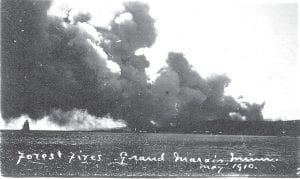Evidence of a “charcoal bookmark” shows that major fires occurred in Northern Minnesota 3000 and 3500 years ago. Severe fires were recorded in 1860, 1871 and 1872, 1878, 1910, 1923, 1926, 1929 and 1936. This photo shows the devastating fire of May 1910. Look at the far left—you can see the Grand Marais lighthouse engulfed in smoke.

As our minds and hearts are preoccupied these days with forest fire, it may be interesting to learn a bit about the history of forest fire in the area that is presently burning. Experts have no doubt that fire raged through the forest in ancient times. There were no trained firefighters then. Because lightning was a major cause of fire then as now, it would have happened and eventually the fire would have burned until fuel was spent or until it was extinguished by rain or snow.
We know a bit more history thanks to a researcher named Dr. J. E. Potzger of Butler University in Indianapolis, Indiana, and his colleagues who explored peat bogs in the Quetico-Superior Forest where they analyzed pollen built up over thousands of years and reported their findings in 1950.
Their core samples showed distinct periods of forestation. The very first forest they documented was made up of white spruce, balsam fir and jack pine and this mix seemingly persisted for a long time. Suddenly there was a marked change in the pollen profile indicating a forest consisting mostly of jack pine. Since jack pine is known to regenerate most prolifically after a hot fire, this may indicate a widespread forest fire followed by the natural succession of jack pine.
The layer near the top of the core sample showed spruce and fir trees again becoming numerous. In general, birch was not a major species but occasionally did become a significant part of the pollen sample. This could be an indication of climate change or more likely, a significant forest fire.
Some evidence was found of a major fire at the Little Long Lake Bog north of Ely. At the seven-foot level of the peat bog, a considerable accumulation of charcoal was noted and labeled a “charcoal bookmark” as it provided definite evidence of a prehistoric forest fire.
Time is measured in the peat bog boring samples by measuring the radioactivity of the carbon found in the peat. Carbon dating led to the conclusion that this charcoal marker occurred between 3000 and 3500 years ago. There may have been other major fires before or after that left no marker or at least not a marker that has been discovered so far.
A totally different indication of the existence of forest fires in early times is that the earliest white explorers found many lakes and rivers with Indian names which translated into “burned.” Examples are the Brule River and Brule Lake, Burnt Lake, and Burntside Lake. Besides lightning, early people may have built campfires or set fires to assist in hunting game or to replenish the supply of blueberries or raspberries.
Written reports have been found dating back to the early 1700s when white men came to the area. Father Jean Pierre Aulneau was an early Jesuit missionary at Fort St. Charles located in Lake of the Woods, arriving at his post in 1735. In a subsequent letter to a fellow priest, he wrote: “On their route a band of Indians on a hunting trip had set fire to the forests. The fire had burst the bounds they had set for it and the entire region was on fire. In addition to the stifling heat and constant horde of stinging insects the Frenchmen had to fight their way through thick smoke. In the evening as they prepared their blankets, the sky glared red from the flames. . . .We journeyed nearly all the way from Lake Superior to Fort St. Charles through a thick stifling smoke which prevented us from even once catching a glimpse of the sun.”
J.D. Cameron, a Hudson Bay Company trader at Rainy Lake a century later in 1826, wrote that in 1803 and 1804 “the whole country almost from one extremity to the other was in a continual blaze and stopt only by the snows of autumn.” He wrote later that beaver were almost extinct “because of the fearful forest fires of 1803-04.”
Other severe fires were recorded in 1860, 1871 and 1872, 1878, 1910, 1923, 1926, 1929 and 1936.
In summary, we know that forest fires burned large parts of the present Superior National Forest from prehistoric times and that there will always be the chance of destructive fire. Since 1700, white men began recording serious fires, adding to our available information. Since 1909, the U.S. Forest Service has been around to protect the lives and property of people living in or near the forest and they have done a magnificent job in this endeavor. They may remind us, too, that the forest does benefit from fire. The trees will return and, in the meantime, such things as blueberries and moose will thrive, increasing the food supply.
Local historian Mary Alice Hansen provides this historic look at fire as the Pagami Creek fire continues to burn. She notes that facts in this article come from material commissioned years ago by the U.S. Forest Service to be used to provide Forest Service personnel background information about the area. Research was done by J. Wesley White.


Loading Comments